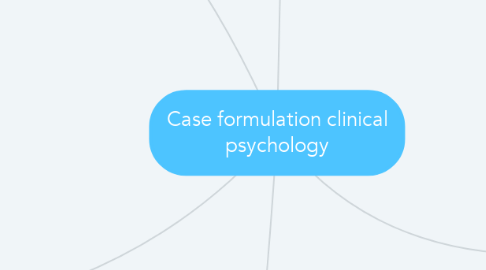
1. References
1.1. González Bravo, Luis Antonio. (2009). Formulaciones Clínicas en Psicoterapia. Terapia psicológica, 27(1), 93-102. https://dx.doi.org/10.4067/S0718-48082009000100009
1.2. Kaholokula, Joseph Keawe´aimoku, Godoy, Antonio, O´Brien, William H., Haynes, Stephen N., & Gavino, Aurora. (2013). Análisis funcional en evaluación conductual y formulación de casos clínicos. Clínica y Salud, 24(2), 117-127. https://dx.doi.org/10.5093/cl2013a13
2. Components of a case formulation
2.1. Most formulations share three basic assumptions:
2.1.1. 1) They emphasize the level of inference that can be easily sustained by the patient's statements 2) The information they contain is based more than on patient reports, on clinical judgment 3) Case formulation is shared into predefined components that are individually completed in the formulation process and then incorporated into a comprehensive formulation.
2.2. This includes:
2.2.1. 1) Symptoms and problems 2) Precipitating stressors or events 3) Predisposing or stressful life events 4) A mechanism that links the preceding categories and offers an explanation of the precipitants and maintenance influences of the individual's problems
3. Clinical formulations in the cognitive approach.
3.1. proposes the generation of explanatory hypotheses for the current problematic behavior, recognizing its historical antecedents and present environmental elements.
3.1.1. Cognitive therapy emphasizes the role of dysfunctional thinking in psychological disorders. Presumably, if the thinking is crooked, then so are the feelings and actions. Treatment provides symptomatic relief by correcting dysfunctional thinking.
3.2. Persons and Tompkins (1997) propose a series of seven elements that would form part of the cognitive-behavioral formulation:
3.2.1. 1) The list of problems
3.2.1.1. It is an exhaustive list of the patient's difficulties, expressed in concrete, simple and descriptive terms.
3.2.2. 2) Core beliefs
3.2.2.1. Here, the therapist offers hypotheses about the view that the patient has about the self, others and the world and that contributes to maintaining the patient's problems.
3.2.3. 3) Precipitants and activating situations
3.2.3.1. External events and situations are specified that activate core beliefs that produce symptoms and problems or that serve as reinforcing stimuli in a functional analysis.
3.2.4. 4) Working hypothesis
3.2.4.1. It is the core of the formulation, where the therapist "tells a story" that links the problems highlighted in the problem list, the core beliefs, and the triggering events and situations.
3.2.5. 5) Origins
3.2.5.1. The therapist describes one or a few incidents or circumstances in the patient's early history, explaining how the patient might have learned the beliefs already identified
3.2.6. 6) The treatment plan
3.2.6.1. En esta sección se señalan las metas e intervenciones derivadas de los puntos anteriores ya mencionados, con los cuales guardan una relación directa.
3.2.7. 7) Obstáculos predichos para el tratamiento
4. A case formulation (or case conceptualization or explanatory formulation) is a model of the mechanisms that cause, control, or maintain the psychological problems of a particular patient.
4.1. The formulation of an investigated case is vital in therapy because the selection of an appropriate treatment requires an understanding of what is causing or maintaining the patient's problems.
5. HAYES O´ BRIEN
5.1. According to Haynes and O'Brien, the formulation constitutes a final objective of the evaluation carried out before the treatment and refers to an integrated set of hypotheses and clinical judgments about:
5.1.1. 1. Behavioral problems, their characteristics. 2. Functional relationships 3. The variables that generate or maintain these problems and the variables that could modify the causes 4. The treatment goals
5.2. Information gathering instruments
5.2.1. 1. Interview: ABC 2. Observation: ABC 3. Self-report: ABC 4. Psychometric tests
5.3. P factors
5.3.1. • Predisposing Factors: Those that appear long before the episode or problem behavior and that increase the vulnerability to present the conduct disorder.
5.3.2. • Precipitating factors: are those stressors that appear just before the episode or behavior problem.
5.3.3. • Perpetuating factors: Those that contribute to maintaining the illness or behavior problem.
5.3.4. • Protective factors: Those that increase the probability that a person will develop certain behaviors that favor their health.
5.4. objective
5.4.1. The main objective is to identify causal, important and controllable relationships for the problems and treatment goals
5.5. Importance
5.5.1. Among the causal functional relationships, emphasis is placed on those that are truly important, which by modifying them can generate greater benefit.
5.6. Control
5.6.1. Controllable variables are especially taken into account since the intervention depends on them
5.7. Hypothetical
5.7.1. The functional analysis is always hypothetical (proposed by the clinician) and is tested for the effects of treatment.
5.8. Insufficient
5.8.1. The functional analysis is always incomplete
5.9. Bias
5.9.1. Functional analysis reflects clinician biases
5.10. Target ABC
5.10.1. Estimate the relative magnitude of the effect of each causal variable to choose the most pertinent treatments that produce modifications in them.
5.10.2. The estimated effect size can be calculated for both causal and treatment variables. Said probability value (0 to 1) allows to indicate:
5.10.2.1. 1. Core problems 2. The modifiability of the causal variable 3. Strength and direction or causal relationships with other variables and behavior problems.
